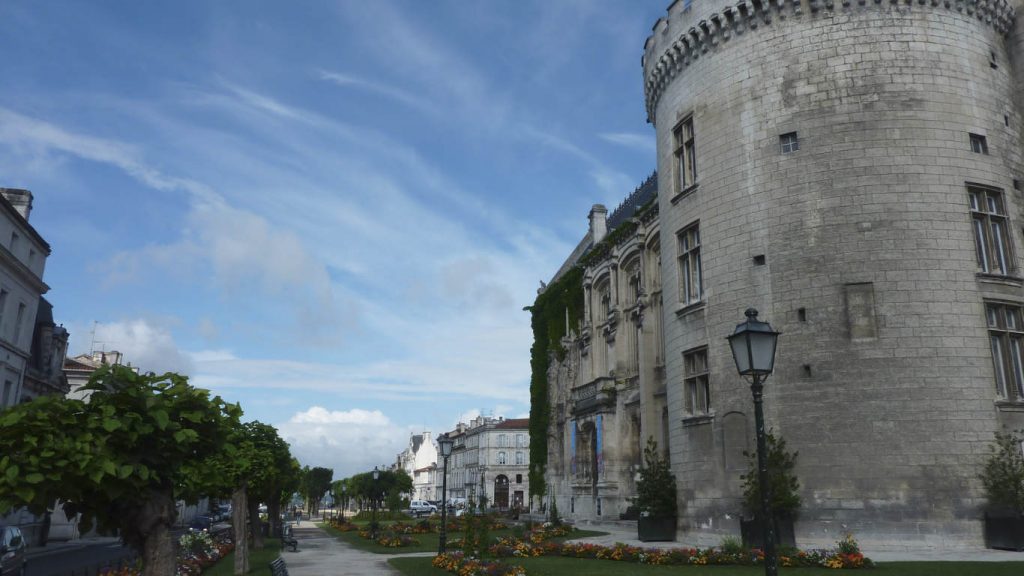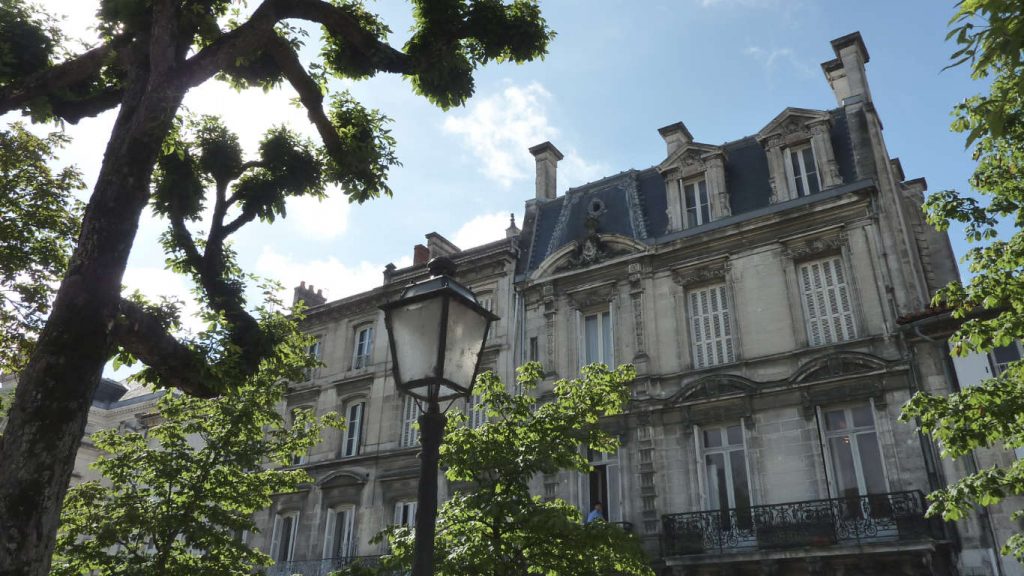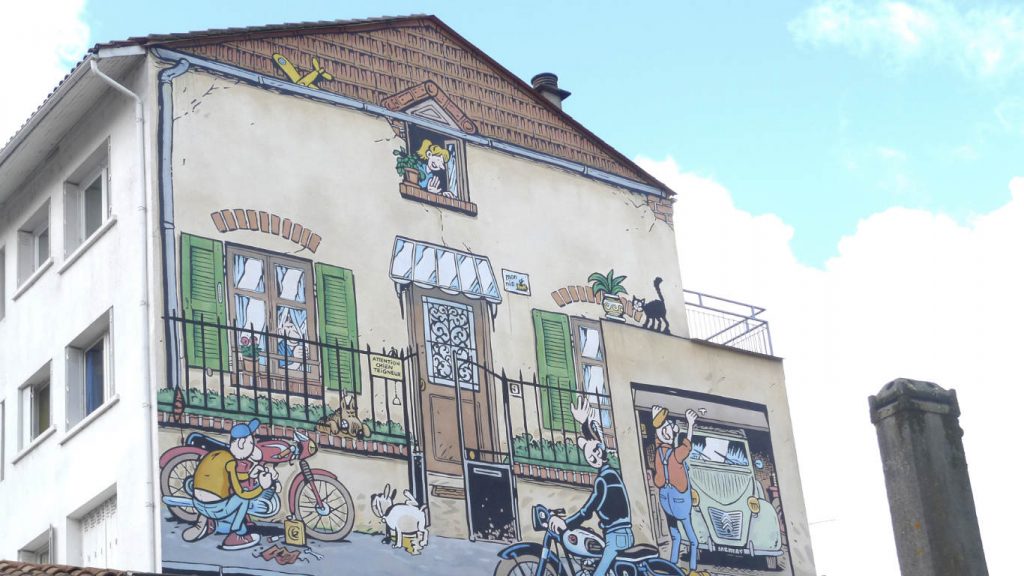
Angoulême
Fall for the attractions of Angoulême and its winding streets, historic buildings, culture and shopping!
If you’re a tourist and visiting for the first time, don’t be put off by the sprawling industrial zone that surrounds the Charente capital. Ignore the huge pre-fabricated buildings and garish signs on the plain and continue climbing until you reach the centre ville. As you will discover, the mood is very different up here with winding cobbled streets of the old quarter and, from the ancient city walls, magnificent views across the valley, the river Charente glistening in the sunshine. Angoulême has plenty of tourist attractions and things to see and do.
History
Walk around the town and you can trace its history. Angoulême dates back to the first century but became politically and historically important during the late Middle Ages. It was during this time that the city walls, called Les Ramparts were first built, as well as St Pierre Cathedral whose spire can be seen from miles around.
It has seen its fair share of battles, being at the heart of the struggle for power between the French and English during the 14th century and then during the French Wars of Religion two hundred years later. During the 18th and 19th centuries the many papermaking mills (now all but disappeared) brought the town great wealth. Today, reminders of these past days can be found in the older medieval style buildings and grander mansion with beautiful facades and thick wooden doors.
What to Do and See
Discover the town
A good place to start your exploration of the old part of the town is Les Halles, the covered market that’s an excellent example of 19th century metal work, with ornate scroll work curling around the roof and walls. Inside are stalls selling fresh produce from cheeses to meat, seafood and fresh fruit and vegetables. If you want to see the market at its bustling best, make sure you go in the morning. (Near the market is the tourist office where you can pick up a leaflet, in English, with a map of the old town including explanations of local tourist attractions, what to see and where to find it.)
More shops and cafés can be found in and around Rue des Postes that leads to Place F Louvel, just past the town hall. Make sure you buy some brightly coloured macaroons or canellés (small pastries with a custard centre), both local specialities.
Walk along les Remparts for a view of the Charente valley. The best vistas are found from Rempart du Midi up to Place Beaulieu. St Pierre Cathedral: an impressive example of Romanesque architecture, whose spire can be seen from miles around. Originally built in the 12th century, seven hundred years later, Paul Abadie who designed the basilica of Paris’ Sacré-Coeur cathedral, added the two towers. It is most famous, though, or its detailed 12 century facade – make sure you see the depiction of the Last Judgement ..
Cordelier’s Chapel: dating back to the 14th century, in the nave is the 350 year-old tomb of Jean-Louis-Guez de Balzac, one of France’s most celebrated writers, who was born in Angoulême.
Also look out for something more modern: the 20 or so walls decorated with cartoon-style murals by a variety of artists and the 1000 or so street name plaques in the form of a speech bubbles. Angoulême is world-renowned amongst creators and fans of this creative medium, and hosts the Comic Strip festival every January.
Visit a museum
Musée de la bande dessinée: devoted to the art of the comic strip – the annual festival on the subject is held every January in Angoulême – and its impact on the world, both culturally and politically, this is arguably Angoulême’s most famous museum. Read more …
Musée D’Angoulême: After years of planning, the museum recently underwent a 6.8 million facelift with the addition of a new wing, at the same time changing its name from Musée des Beaux-Arts to the grander Museum of Angoulême. Over three floors plus the crypt, it covers archaeology, artefacts from the Maghreb, Africa and Oceania, French paintings and sculpture from the 16th to 20th centuries plus the complete reconstruction of a 19th century salon, down to the carved panelling and parquet floor. 1 rue Friedland, Square Girard II, côté jardin; Tel: +33 5 45 95 79 88.
Le Nil Paper Museum: Joseph-Bardou manufactured the famous ‘Le Nil’ cigarette papers (hence its name), and this museum which shows the history of the paper history both locally (Rizla had a factory here) and around the world is housed in his former paper mill. 134, rue de Bordeaux; Tel: +33 5 45 92 73 43.
Musee de la Resistance et de la Deportation: the story of the French resistance during WWII both locally and nationally, using real life stories, documents and maps. 34, rue de Genève; Tel: +33 5 45 38 76 87. It is now part of the local archives department and is not always open to the public; it’s best to give them a call first before visiting.
If you happen to be visiting during the third weekend of September …
Come see the vintage cars: on this weekend, the old town is given over to vintage cars from all over the world who compete in Circuit des Remparts, fondly known as ‘Monaco without the sea’. A series of races is held over three days within the town and is great fun with loads of atmosphere.
What to see and do near Angoulême
Cognac: The medieval town of Cognac with its narrow cobbled streets that are a mix of medieval stone as well as more elegant Renaissance facades. By the river are the many chais, old warehouses that have for many hundreds years stored barrels of maturing cognac, and through which you can take a guided tour. Read more …
Saintes: on the river Charente, is known for its Roman remains including a vast amphitheatre built for gladiatorial combats, and busy Monday market. Read more …
La Rochefoucauld château: in the town of the same name is this striking chateau. The oldest part of the castle dates back to the year 980 but much of it was rebuilt in the 11th and 18th centuries, the solid Romanesque square in sharp contrast to the fairytale-style turrets and elegant cloisters. Read more …
Villebois-Lavalette: a town set on a hill and dominated by a feudal castle first built in the 10th century – it is still possible to see the chapel, outer walls and round towers from this period. As with many castles in this area, it was added to over the following 300 years and from the top of this part of the castle you get fantastic views of the Dordogne valley. Read more …
Tusson: the medieval village of Tusson is famous of being the place where Marguerite d’Angoulême, the sister of King of Francois 1st and known for her political influence and literary work, lived after she withdrew from court. Read more …
Historic Mills
Restored mills: the river Charente has long been an important part of life here, both as a means of transport as an energy source. Not far from Angoulême is the Horte-et-Tardoire valley where are a number of mills that have been restored to working use.
Paper: The Charente was once the epicentre of paper-making in France with the mills of Angoulême and its surrounds working continually to transform linen, cotton and hemp into paper and vellum that was used for official government documents and to make banknotes. Today the industry has all but disappeared although there are a couple of mills still making paper the traditional way with the paper used in the restoration of old books and documents.
The Moulin Papier du Verger, Puymoyen, has been a mill since 1589.
It’s open Monday-Friday, between 4pm-6pm; Tel: +33 5 45 61 10 38; www.moulinduverger.com
Moulins de Menet and de Chabrot, Montbron: both date back to the 19th century, making different kinds of flour. Today you can buy flour from both, and the Moulin de Chabrot bakes its own bread.
Moulin de la Chaume, St-Germain-de-Montbron: on the Bandiat river, this 17th century mill produces walnut and hazelnut oil as well as stoneground flour.
Moulin de la Pierre, Vilhonneur: the only mill in France to cut limestone using hydraulic energy.
Arboretum Jean Aubouin du Clédou
Created by the botanist in 1932, it stretches over 10 hectares. Take the trail created by the Office National des Forêts to see trees from almost 40 countries including the giant sequoia. La Mothe-Clédou, Tel: +33 5 45 64 71 58
PRACTICAL INFORMATION:
Tourist office: 7 bis rue du Chat, Place des Halles, Angoulême; Tel: +33 5 45 95 16 84, www.Angoulême-tourisme.com
Getting to Angoulême
Travel: Poitiers airport is about an hours drive away. The TGV from Paris takes between 90 minutes and two hours.
Photo 1 by David Hamill / CC BY 2.0 image cropped; Photo 2 by jean-louis Zimmermann / CC BY 2.0 image cropped; Photo 3 by David Hamill / CC BY 2.0 image cropped; Photo 4 by Karen Green / CC BY 2.0 image cropped





